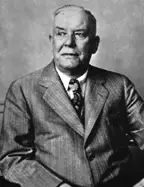 Wallace Stevens (October 2, 1879 – August 2, 1955) was an American Modernist poet.
Wallace Stevens (October 2, 1879 – August 2, 1955) was an American Modernist poet.
Life
Born in Reading, Pennsylvania, Stevens went to college at Harvard, after which he moved to New York City and briefly worked as a journalist. He then attended New York Law School, graduating in 1903. By 1908 he had been hired as a bonding lawyer for an insurance firm, and by 1914 he was the vice-president of the New York Office of the Equitable Surety Company of St. Louis, Missouri. When this job was abolished as a result of mergers in 1916, he joined the home office of Hartford Accident and Indemnity and left New York City to live in Hartford, where he would remain the rest of his life. By 1934, he had been named vice-president of the company.
On a trip back to Reading in 1904, Stevens met Elsie Moll, whom he married, after a long courtship, in 1909. The marriage reputedly turned cold and distant, but the Stevenses never divorced.
Stevens got his first book of poetry, Harmonium, published in 1923, and produced only two
more major books of poetry during the 1920s and ’30s. He came out with three books of poetry in the 1940s, however, and his best poetry was written after he turned 60. It was in this later period that Stevens began to be recognized as a major poet, and he received the National Book Award in 1950 and 1954.
Poetry
Stevens’ subjects are the interplay between imagination and reality, and the relation between consciousness and the world. In Stevens, “imagination” is not equivalent to consciousness or “reality” to the world as it exists outside our minds. Reality is the product of the imagination as it shapes the world. Or rather, as the title of one of his late poems puts it, Stevens sees reality “as the activity of the most august imagination.”
Reality is an activity, not a static object, because it is constantly changing as we attempt to find imaginatively satisfying ways to perceive the world. Stevens sees the poet (who, as for Wordsworth, is qualitatively the same as other people) as continually creating and discarding cognitive depictions of the world. These cognitive depictions find their outlet and their best and final form as words; and thus Stevens can say, “It is a world of words to the end of it, / In which nothing solid is its solid self.” His most general and impressive statement in this vein comes in a poem called “Men Made out of Words,” in which he says: “Life / Consists of propositions about life.”.
Stevens also believed that, for life to be worth living or (what was for him a very similar thing) poetry to be worth reading, the words we choose to express the world must constantly change. As he noted in “The Man with the Blue Guitar”:
- Throw away the lights, the definitions,
- And say of what you see in the dark
- That it is this or that it is that,
- But do not use the rotted names.
Constant change is necessary for two reasons. First, our world can be seen not as a whole, but in parts, and changing parts at that. We live in a world of “pitches and patches”; we are
- Thinkers without final thoughts
- In an always incipient cosmos,
- The way, when we climb a mountain,
- Vermont throws itself together.
Second, without change life and poetry would be stagnant, as Stevens depicts heaven as being in his best-known poem, “Sunday Morning”: “Is there no change of death in paradise? / Does ripe fruit never fall?” “Death,” says Stevens in the same poem, “is the mother of beauty,” because only that which changes is beautiful, and death is the last form of change and the guarantor of transiency.
Stevens was well aware that the intellect is often used to avoid reality rather than confront it. In “Loneliness in Jersey City” he parodies both religious and scientific analysis with meaningless statements such as “The deer and the dachshund are one” and:
- The distance between the dark steeple
- And cobble ten thousand and three
- Is more than a seven-foot inchworm
- Could measure by moonlight in June.
As Stevens notes in the same poem, “The steeples are empty and so are the people” – religion and science have tended to find comfortable substitutes for reality rather than describe it accurately.
The need constantly to re-create reality is what makes Stevens’s work so various but at the same time so unified. Along with his flawless ear and constant inventiveness, it is what gives rise to the verbal pyrotechnics of his poetry.
Although there necessarily cannot be a final destination to Stevens’s poetry, some of the greatest moments of his poems come when Stevens catches a glimpse, so to speak, of the secular transcendence that ultimately lies beyond a poem – for example, when in “To an Old Philosopher in Rome”, he speaks of “Things dark on the horizons of perception”, of “the shadow of a shape” that constitutes
- A light on the candle tearing against the wick
- To join a hovering excellence, to escape
- From fire and be part only of that of which
- Fire is the symbol: the celestial possible.
Reception and Influence
From the first, critics and fellow poets recognized Stevens’s genius. While in college, he exchanged sonnets with George Santayana. In the 1930s, the rationalist Yvor Winters criticized Stevens as a decadent hedonist but acknowledged his great talent. Hart Crane wrote to a friend in 1919, after reading some of the poems that would make up Harmonium, “There is a man whose work makes most the rest of us quail.” Beginning in the 1940s, critics such as Randall Jarrell spoke of Stevens as one of the major living American poets, even if they did so (as Jarrell did) with certain reservations about Stevens’s work.
After Stevens’s death, it was Harold Bloom who did the most among critics to assure Stevens’s position in the canon as a great poet, and perhaps the greatest American poet of the 20th century. Other major critics, such as Helen Vendler and Frank Kermode, have added their voices and analysis to this verdict. Many poets, James Merrill and Donald Justice most explicitly, have acknowledged Stevens as a major influence on their work, and his impact may also be felt in John Ashbery, John Hollander, and others.
